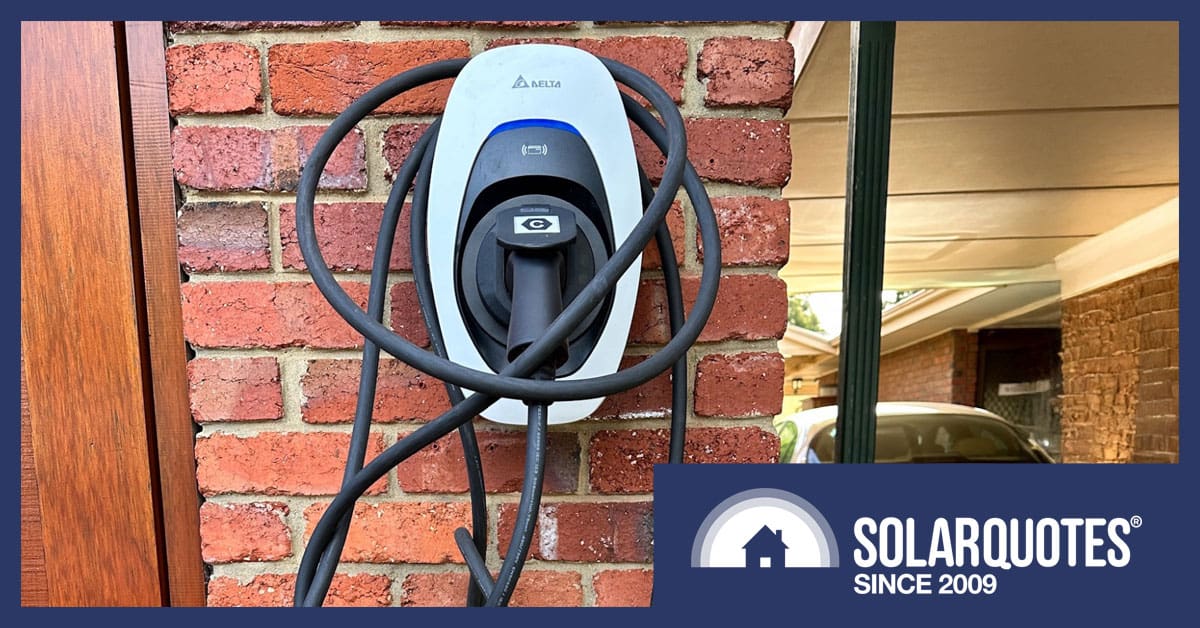
Charging your car involves cables, so we’ve gathered a few hints and really useful tricks for managing the situation without accidentally killing someone.
Cable Organisation Isn’t Hard
EV charging cables are damage-prone. When cars are involved, running them over, cutting, dragging, and kinking is easy.
Electrical flex can easily strike back, though. Trips, falls, twisted ankles and broken belongings are equally as easy when people are involved.
I can speak with authority about people and power cords. When I was at All Covers Rooofing, my job was to save workers from themselves.
As much as people decry tagging and testing, every three months I had to run my hands along 500 metres of extension cords that were invariably sliced open on sharp metal cladding.
The boss laughed at me for tagging the workshop kitchen appliances too, but when I found the sandwich press cord had been toasted, he actually nodded with approval.
There are really only two kinds of people in the world: those who can coil a cable neatly and those who deserve to be hung from the yard arm with their own knotted mess of electrical cords.
Hang Your Cords Up
The simplest way to avoid damage to EV chargers, charging cable, plug end, and the people using it; is to get it up off the floor.
Cable stands still clutter the place
Industry standards and workplace safety laws require extension cords to be suspended off the floor on Australian construction sites. Hooks, clips, brackets, and stands are available for the job, but they are aimed at temporary installations on building sites.
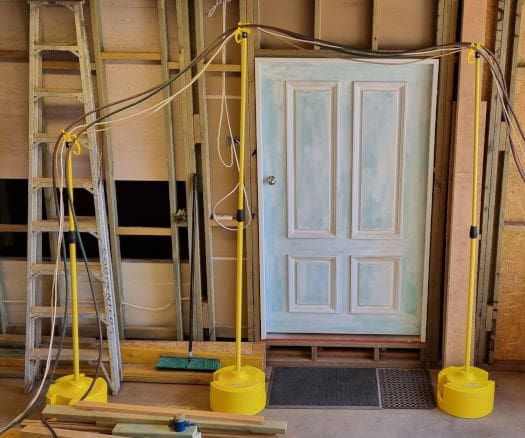
A decent site foreman makes all the difference.
High Wire Acts Are Great
An old car club friend devised this solution for putting a maintenance charger on his Jaguar. It’s simply a clothesline wire strung tight across his shed to support his extension cable. Vale Laurie, your taste in cars and decor was very classy.
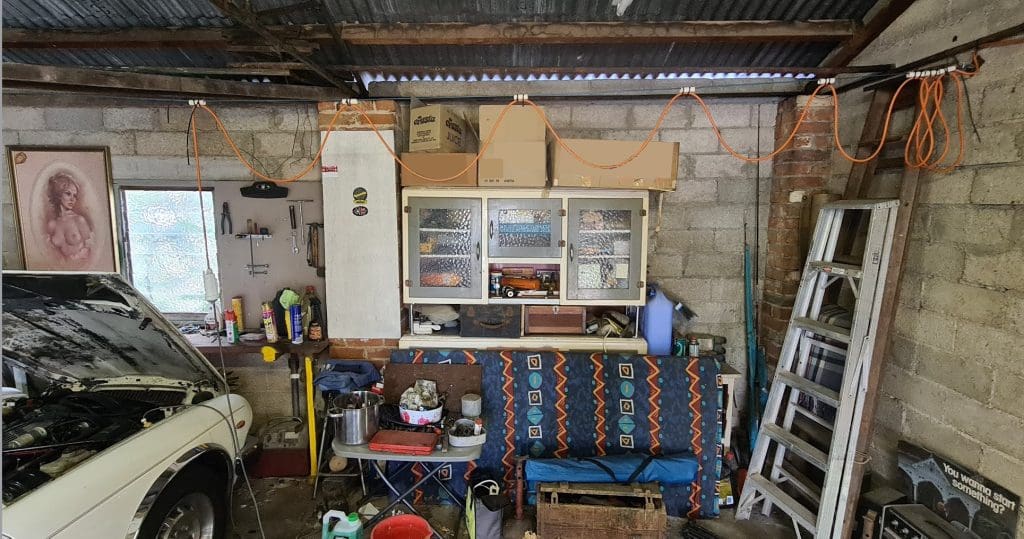
Small pieces of conduit allow the cable to slide nicely along the catenary
For the full “old retired bloke” aesthetic, this really needs a tennis ball suspended in front of the windscreen so you can stop the car in just the right spot. This is something to consider if you have a household solar battery in your garage.
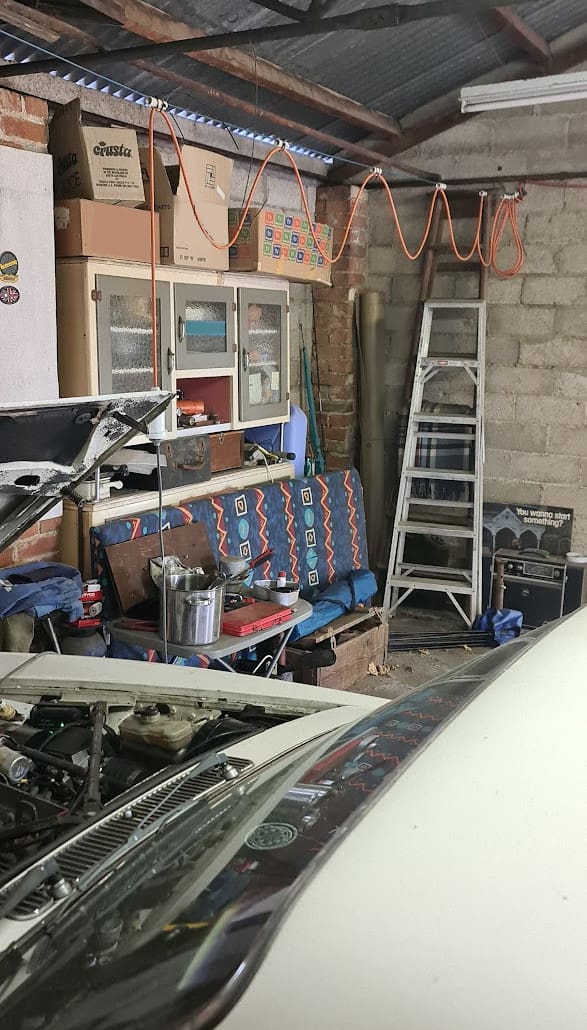
Despite the rest of the clutter, this keeps the cords tidy
Type 1 EV Charging Example
As I have yet to install a “proper” EV charging unit, my approach to EV charging serves two main purposes.
It keeps the EVSE unit out of the rain and stops my lovely wife from hanging the charging plug on the mirror of my ute.
For the sake of the experiment, this unit is connected using an extension cord (white).
However, the excess length in the black charging lead is suspended in a series of loops, with the last drop being short enough that the plug doesn’t hit the ground when it’s removed from the car.
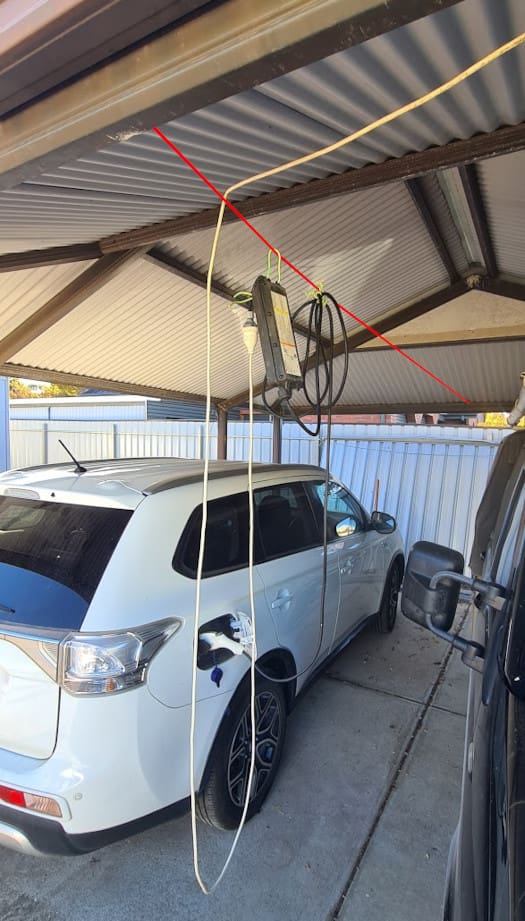
I’ve highlighted the catenary cable in red
I’ve moved the catenary cable now, so it traverses the parking bay diagonally.
If the car is reversed in or we have a different vehicle, I can simply tug the cord across to the opposite corner of the space.
Once I’ve sorted a 10mm² cable from the main switchboard, this carport will likely have a dedicated power point and possibly even a 7kW EV charger.
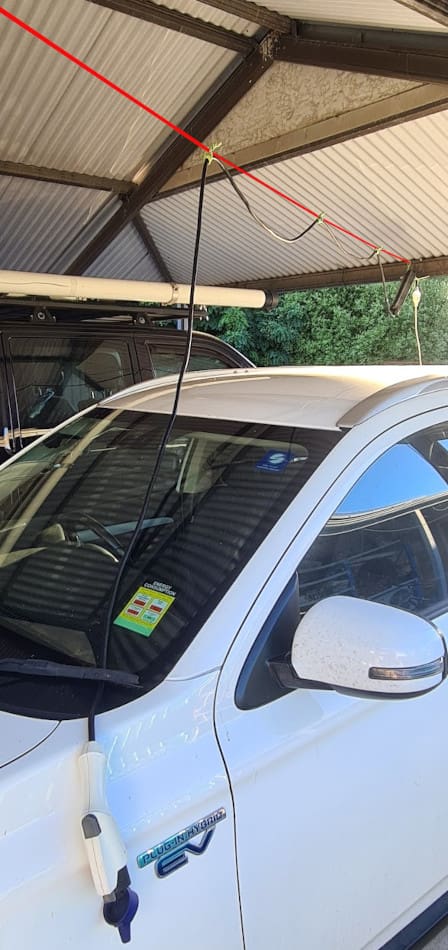
Different EVs have sockets all over them
Catenary Is Electrician Speak For Cable Support
Any electrician will be familiar with a catenary arrangement; the parts are available at any hardware shop.
I created my trackway using plastic-coated steel cable, clamps, and a stout spring leftover from a trampoline.
A turnbuckle may be easier to assemble, but with this lightweight carport structure, there’s some danger of tearing out the screws or bending something if you crank it up too tight.
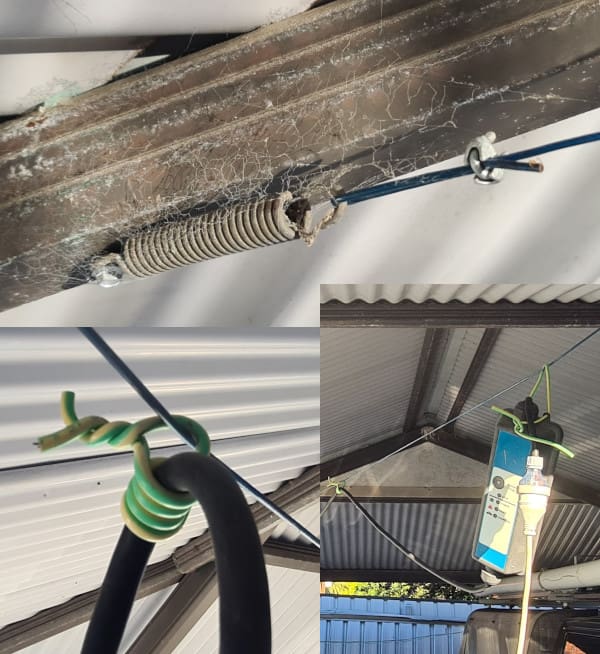
This catenary wire is under a lot of tension, so the bolt holding this spring in place goes all the way through the purlin.
Using what I had to hand meant twitching some infinitely adjustable pieces of plastic-insulated copper wire as cable grips. The main points to observe are that your cable doesn’t move in the supports, but the supports are free to move along the catenary.
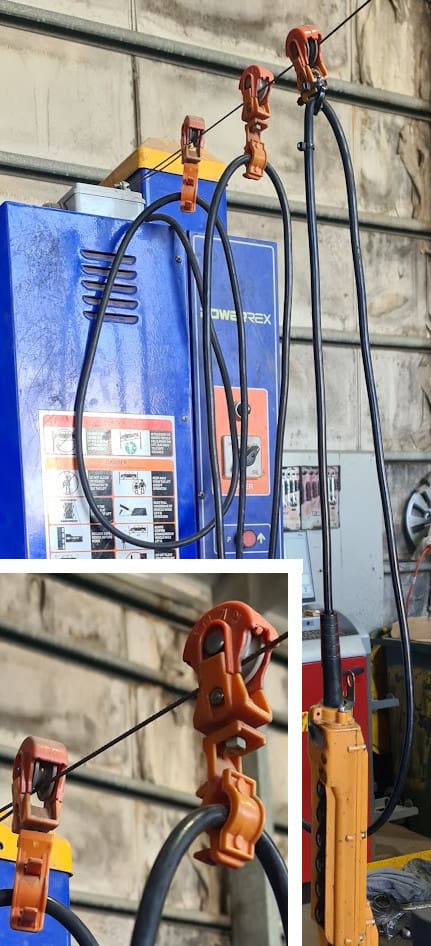
These pulleys are a proper industrial solution to a suspended cable, as found on a 4 post car hoist in a workshop
Flexibility Is Handy
If your mates come to visit and you must ensure they have enough charge leave,1 it’s worth bearing in mind the charging cable might need to reach elsewhere.
I always recommend you carry a spare cable in the car just for redundancy, but using some shower curtain hooks on my existing setup would also work well.
Removing the first support or two may be just enough to connect a second car outside without resorting to tools for disassembly.
Fishing Rods Are The Other Option
Don’t laugh; the pedants from Boroondara Council aren’t.
Even though the local authorities didn’t bless this elegant solution, it’s still a perfectly good use for a fishing rod that offers less obstruction to pedestrians, prams and wheel chairs than the council parking sign does.

Flexible insulated fibreglass with incremental eyelets, you could hardly ask for a better device to carry a flexible cable
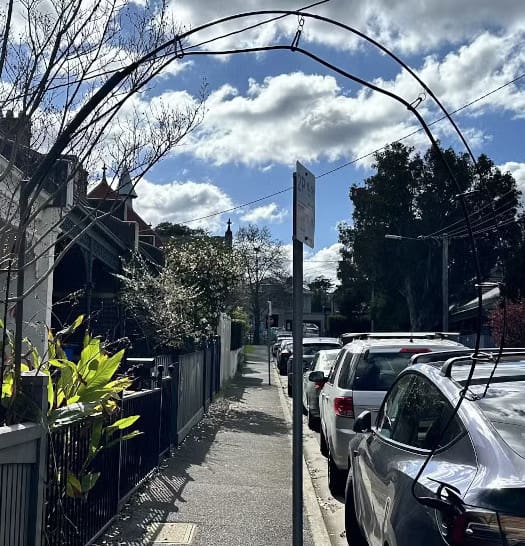
If fishing was any good, they’d call it catching.
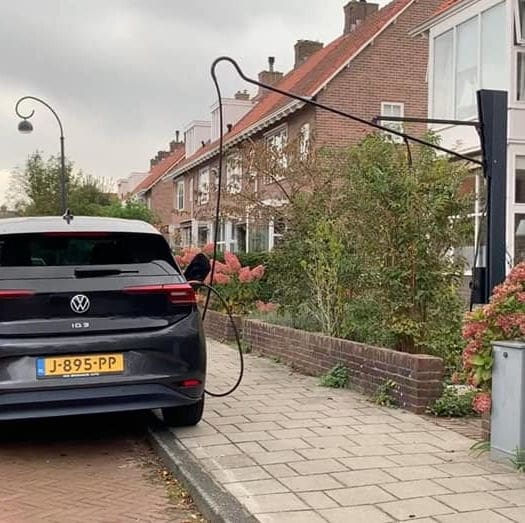
In the UK this is called a “charge arm”
If you’re into god-level DIY projects, then an articulated arm to carry your power, lights and maybe compressed air for tyres is a real showstopper.
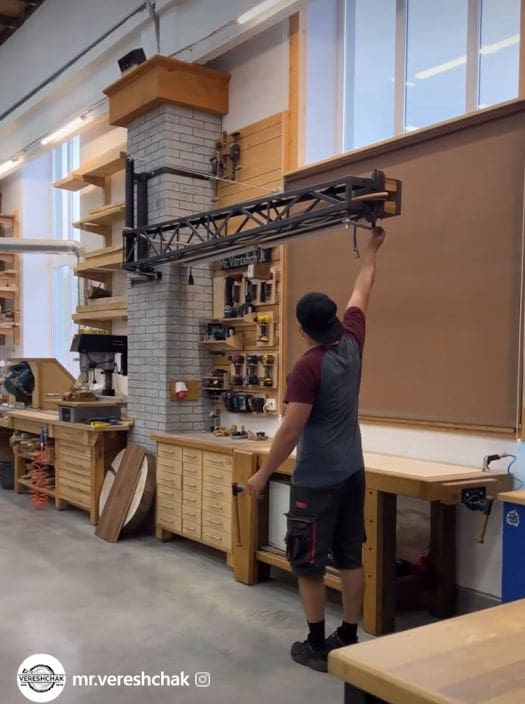
I have built one of these because it saves a lot of time rolling extension cords

However the double joint which offers quadruple the flexibility is just gold.
Risk Management Is A Duty Of Care
If your EV is charging quietly in the driveway when someone comes marching up to sell you some unsolicited solar energy, they might trip over the big fat cable lying next to the car.
While I’d argue it serves them right for being a dodgy sales company rep, there’s some chance they could take you to court.
It’s why household insurance has a public liability clause.
It’s a better bet to make your place safe and use a garden hose to drive off the religious callers2 and door-to-door sales reps.
Making them go home dripping wet saves anyone else having to deal with them.
It’s a public service.
Footnotes
- Remember a couple of hours charging on a standard power point costs half that of a tin of beer, we can afford to be generous with this ↩
- True Story: As kids, my best mate would scramble through his grandfather’s house with a kinked-off hose, so the door knockers would be met with a shower of water through the screen door, followed by howls of laughter ↩

 RSS - Posts
RSS - Posts



The old Victron EVSE was (is?) square, the newer one is oval, to serve as a cable reel. Mine is on the little bit of wall between two garage doors, less than 2m from the left rear charge port on the MG4. After charging, with one hand on the extracted plug, the other grabbing the middle of the cable from the floor, replaces that over the EVSE housing, and the plug goes into the adjacent dummy holding socket so nothing dangles. All stowed in a second and a half, as a single 1.5 turn loop
While charging, the great fat heavy cable hugs the floor like a black snake – very hard to trip over.
A visitor’s car can easily pull up to the garage door, reversing if necessary, to plug in outside instead.
All of it is physically much like using a petrol bowser, as the 7 kW cable is similarly short, thick, heavy, and compactly stowable, straight out of the box.
I’m thinking of putting a second one in, even if that necessitates a higher rated comb in the switchboard. The two 8 kVA Victrons feed the switchboard through a ganged 63A breaker pair, and the two 6 kW Fronius PV inverters have a 32A breaker each. So delivering 15 kW to two EVSEs is well within capacity, even off-grid – in ample sun. Putting the EVSE(s) in “Automatic” mode delivers only surplus solar, if preserving domestic battery SoC is on the agenda.
There isn’t much more evolution needed in this stuff, I figure.
Great explainer Eric,
How do you find the Victron EVSE for solar charging?
I suspect it’s the best/only option for dynamic control off grid really.
However I know the first release of firmware wasn’t ready for market, it simply didn’t work.
Hi Anthony,
The first software version was less than ideal – I’d grumped about it for half a year, not least to Victron. In the last fortnight the wholesaler’s tech expert offered an over-the-internet remote upgrade. Now it’s all this off-gridder could ask for. (Many thanks, Gareth.)
It was really only “Automatic” mode, taking only surplus solar for EV charging, which had been unreliable – not auto-starting even in bright sun. Simply selecting “Manual” mode, and ramping EV charge rate to roughly match insolation worked OK for me through three seasons. (You get used to it, at least when retirement affords the time to have a look now and then.) With control access via the phone app, over LAN from the PC, or the Cerbo’s touch screen, manual intervention didn’t involve getting off the sofa. But now it tracks insolation automatically, still feeding dwindling daylight at 7:30 p.m. the other day, without off-grid battery drain.
It’ll be interesting to put in a second one next year, if I can get my hands on a compact EV tractor.
The new MG4 has already done around 7500 km, entirely photon-propelled, so nearly 1.3 MWh net through the EVCE. At 15,000 km p.a., an EV can “export” over 2.5 MWh p.a. *off-grid*, in fossil fuel displacement, thus 100% CO₂ emissions reduction. On-grid export might mostly displace other renewables, when AEMO is throttling them to favour coal-powered “network stability services” – at least until exponential growth of gridscale batteries replaces that too.
Aaaand, being off-grid allows running 3 aircons and EV charger(s) flat out despite any and all grid outages or consumer throttling for grid protection. That’s DIY climate resilience, and reduced grid load, I figure.
My on-grid brother has now also installed a Victron EVSE, just using “Manual”, as on-grid, “surplus solar only” isn’t a big deal. His square box has a display, but doesn’t serve as a cable reel, like the oval one. With display on the phone, cable convenience is king, I feel.
That brother has turned up in a BYD Seal (Hybrid EV). To charge it quickly, for a trip into town after lunch, whacking the Victron EVCS into “Manual” and cranking up to 7.3 kW does that job, at the expense of almost pulling the 46 kWh off-grid battery down from 100% to 99% as it contributes up to 1.6 kW in clouds, rather than the charge rate dropping as in “Automatic” mode.
When done, I’ll go back to “Automatic” for my normal more relaxed EV charging rate, just to make sure the battery ends each day at 100%. It’s just a tap on a button on the phone app to change. All this newfangled stuff isn’t hard to drive at all, even for a 70 y.o.
excellent reading, loved the diy wire, the mickey mouse wires.
photovoltaic / solar thermal technician here from california. solar panels on roof. i do top notch work safety first. can’t say 100% in one specific place, it’s come at your own risk. keeps pesky people out. it’s electricians nightmare plus have roadkill that i’ve skinned. guests have come take one look and won’t enter. just the way i like it
FVP